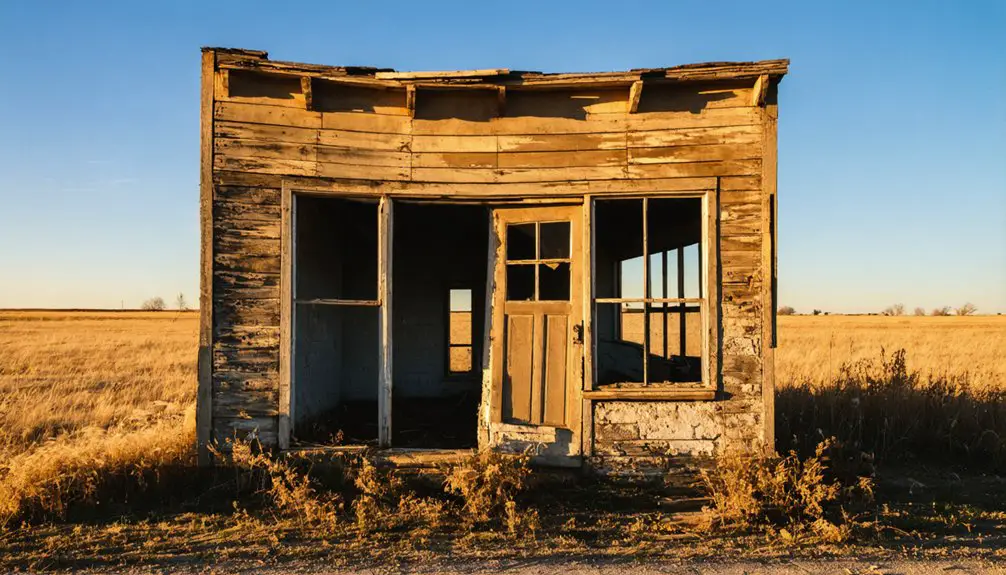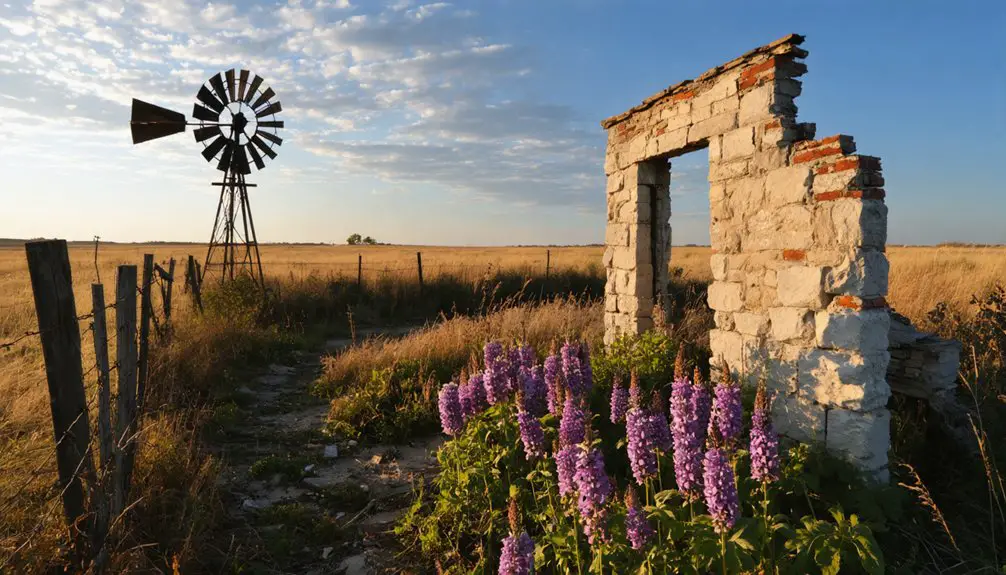You’ll find Guilford in Cherokee County, Kansas, where it began as a bustling mining town in 1877 established by West Joplin Lead and Zinc Company. The town quickly grew to 3,000 residents within a year, thriving on mining and agricultural trade. Repeated tornado strikes, including a devastating 1956 F4 tornado, combined with economic shifts and mechanized farming, led to its dramatic decline. Today, only a weathered brick school and scattered ruins hint at the fascinating story behind this prairie ghost town.
Key Takeaways
- Founded in 1877 as a mining town by West Joplin Lead and Zinc Company, Guilford rapidly grew to 3,000 residents within its first year.
- Multiple tornadoes, including a devastating F4 in 1956, repeatedly struck the town, causing significant damage and hindering recovery efforts.
- The town’s population declined 80% during the mid-twentieth century due to agricultural mechanization and young people moving to urban areas.
- Only a weathered brick high school, scattered homes, and remnants of grain elevators and railroad infrastructure remain in present-day Guilford.
- Nature has reclaimed most of the town’s infrastructure, transforming former streets and buildings into prairie land visited by ghost town enthusiasts.
The Rise of a Mining Frontier Town
When the West Joplin Lead and Zinc Company purchased land in Cherokee County in 1877, they established what would quickly become one of southeast Kansas’s most prominent mining boomtowns.
Within a year, you’d have found nearly 3,000 residents flocking to Guilford, drawn by the promise of rich lead and zinc deposits that lay beneath the earth.
You’d have witnessed immigrant miners from Europe working alongside East Coast migrants, bringing their mining techniques and cultural traditions to this bustling frontier settlement.
The town’s rapid growth sparked fierce competition with nearby Galena, as merchants advertised in multiple languages to attract workers.
Despite dangerous underground mining conditions requiring miners to supply their own equipment, Guilford’s strategic location in the heart of Cherokee County’s mineral-rich region positioned it as a formidable player in the area’s fossil mining boom.
The town’s social scene quickly evolved to include saloons and gambling halls, transforming the once-quiet frontier settlement into a lively entertainment destination.
Like many mining communities of the era, workers endured harsh conditions in inadequate camp housing while pursuing opportunities in the mines.
Daily Life in Guilford’s Glory Days
After a long day at the limestone quarry, you’d find Guilford’s workers gathering outdoors for cookouts and social activities in the town’s open spaces.
You could spot groups of men enjoying hunting trips and casual gatherings, sharing stories of their daily work experiences.
The town’s playful spirit showed in details like the “Slow Men playing” sign, reflecting the close-knit nature of this Kansas mining community during its peak population of 200 residents.
Like many towns in the region, Guilford faced severe population decline as industry and opportunities shifted elsewhere.
The proximity to the Oregon Trail brought travelers and trade opportunities that helped sustain the town’s early growth.
Mining Workers’ Social Life
Despite the harsh realities of mining life, Guilford’s workers fostered a vibrant social culture during the town’s peak mining years. You’d find miners gathering at local saloons after exhausting shifts, sharing stories and building mining camaraderie that helped them cope with the dangerous work underground.
European immigrant families stuck together, maintaining their traditions through cultural preservation in their tight-knit communities. Many families preserved their Little Balkans heritage through traditional foods, music, and customs passed down through generations. The towns even featured opera houses where miners and their families would gather for entertainment and cultural performances.
Baseball games became a favorite pastime, offering you a much-needed escape from the demanding work schedule. If you weren’t at the ballfield, you might’ve been participating in union meetings or community gatherings that strengthened worker solidarity.
While company stores controlled much of daily commerce, the social bonds you formed through these activities created an unshakeable sense of community that defined life in Guilford’s mining heyday.
Community Gatherings After Hours
The vibrant nightlife of Guilford extended far beyond the mining shifts, transforming the town into a hub of social activity during its peak years in the early 1900s.
You’d find residents gathering at the town’s numerous bars and saloons for evening socials, while the four churches hosted regular services and community events that strengthened local bonds. From impromptu porch gatherings to organized town meetings, Guilford’s after-hours scene buzzed with community bonding opportunities. Like many towns that became ghost towns in Kansas, Guilford’s social vitality gradually faded as economic conditions worsened. Similar to the settlers who established Thomas County in 1873, the early residents came from diverse backgrounds seeking new opportunities.
- Seasonal celebrations brought townspeople together for harvest festivals, baseball games, and holiday parades with fireworks.
- Schools and churches doubled as venues for adult education, civic meetings, and charitable events.
- Families often hosted neighborhood potlucks and barn dances, fostering connections through shared meals and music.
Economic Drivers and Business Hub
Like many Kansas towns of the 19th and early 20th centuries, Guilford established itself as a vibrant agricultural trading center where local farmers converged to conduct business.
You’d find a bustling marketplace with general stores, boot shops, and hardware retailers serving the surrounding rural community. The railroad station played a vital role in the town’s economic sustainability, connecting local producers to broader markets. Similar to other towns, when railroad lines extended elsewhere, business activity began to decline.
However, agricultural innovation led to dramatic changes. As farming technology improved, larger farms required fewer workers, triggering a population exodus. The Dust Bowl era contributed significantly to the town’s decline, forcing many farming families to abandon their lands.
Young folks moved to cities seeking employment, and the reduced rural population couldn’t support local businesses. One by one, stores closed or relocated.
Despite its early promise as a regional hub, Guilford’s role as a trading center gradually diminished, challenging its commercial viability.
Natural Disasters and Their Impact
If you’d visited Guilford in the late 1800s, you’d have witnessed the devastating impact of tornadoes that repeatedly struck the Kansas town, destroying key buildings and infrastructure.
The community’s attempts to rebuild after each storm placed tremendous financial strain on local resources, with many structures never fully restored to their original condition.
These destructive weather events, combined with the town’s existing economic challenges, accelerated Guilford’s population decline and eventual transformation into a ghost town.
Devastating Local Tornado History
Since its early settlement days, Guilford Township has endured nature’s most violent storms, with Kansas experiencing 4,867 tornadoes from 1950 to early 2025.
You’ll find stark evidence of local resilience in the community’s response to the devastating F4 tornado that struck in 1956, causing 29 injuries and leaving a path of tornado destruction across the township.
- The 1956 F4 tornado packed winds up to 260 mph, leveling well-constructed houses.
- Guilford’s location in a high-risk area has seen 1-3 strong/violent tornadoes since 1950.
- The township faced multiple tornado outbreaks, which often included giant hail and straight-line winds.
Kansas ranks 8th nationally for severe tornado density, and Guilford’s history reflects this dangerous reality, with the area seeing EF3 or stronger tornadoes almost every year.
Rebuilding After Storm Damage
The aftermath of devastating tornadoes in Guilford brought immense challenges to the township’s rebuilding efforts throughout the mid-1900s.
You’d have seen how the town’s rebuilding strategies shifted as the economic landscape transformed from mining to agriculture, requiring different types of infrastructure and community support.
The town’s community resilience showed in their focus on preserving essential structures like schools and churches, which served as anchors for the remaining population.
Yet you’ll notice how limited funds and declining industry made full reconstruction impossible.
While some historical buildings survived as proof to Guilford’s past, the loss of crucial infrastructure and population ultimately restricted the town’s recovery.
The diminished tax base and workforce meant that despite preservation attempts, Guilford couldn’t recapture its former liveliness.
Weather’s Role In Decline
Weather-driven calamities repeatedly battered Guilford throughout the mid-1900s, creating a devastating cycle of destruction that accelerated the town’s decline.
The region’s unpredictable weather patterns, from violent tornadoes to severe droughts, struck mercilessly at the town’s core. You’d have witnessed the brutal impact of climate variability as it crippled local farming, disrupted mining operations, and repeatedly flooded essential infrastructure.
- Tornadoes destroyed homes and public buildings, leaving few structures standing
- Harsh droughts devastated crops and weakened the agricultural foundation
- Flooding damaged roads and farmland, isolating the community
The combined assault of these natural disasters proved too much for Guilford’s residents.
With each weather-related setback, more families chose to abandon their properties, ultimately transforming this once-vibrant community into a ghost town.
The Slow Fade Into History
During the mid-twentieth century, Guilford’s vibrant community life began slipping away as its population plummeted by roughly 80% from its peak.
You’d have witnessed dramatic changes as key institutions shuttered their doors – the local school closed in 1965, soon followed by the post office. These closures accelerated the community’s decline, making it harder for remaining residents to maintain their way of life.
Population trends showed young people moving to urban areas for better opportunities, while mechanization of farming meant fewer workers were needed to work the land.
Without new industries to replace agricultural jobs, you couldn’t find enough economic reasons to stay. The improved road networks that once promised progress ironically made it easier for folks to leave, as they could now commute to larger towns for work and services.
What Remains Today

Visiting Guilford today reveals a stark contrast to its once-bustling past. As you explore this Kansas ghost town, you’ll find remaining structures that tell the story of its former glory. The brick high school stands as a silent sentinel, though now severely weathered, while scattered homes and business buildings dot the landscape in various states of decay.
- Old grain elevators and railroad remnants remind you of the town’s agricultural and transportation heritage.
- Nature has reclaimed many streets and lots, with vegetation overtaking former roadways.
- A handful of buildings might still see occasional use by the few remaining caretakers.
You won’t find many permanent residents here now, but ghost town enthusiasts regularly visit to document the site’s gradual evolution back to prairie. The deteriorating structures serve as a powerful reminder of how quickly a thriving community can fade into history.
Frequently Asked Questions
Are There Any Documented Murders or Crimes From Guilford’s Mining Days?
Ever wonder what really happened in those dark mine shafts? You won’t find documented murders from Guilford’s mining days – local folklore focuses more on mining accidents and disasters than actual crimes.
What Native American Tribes Originally Inhabited the Guilford Area?
You’ll find the Kanza, Osage, Pawnee, and Comanche peoples originally inhabited this land, each contributing to its rich tribal history and cultural significance before government-forced relocations in the 1800s.
Did Any Famous Outlaws or Historical Figures Visit Guilford?
You won’t find documented outlaw visits or encounters with famous historical figures here. While mining towns often attracted rough characters, there’s no credible evidence of notorious individuals stopping in this area.
Were There Any Known Underground Tunnels or Secret Passages in Guilford?
You won’t find any confirmed tunnel discoveries or secret passages here – unlike nearby Ellinwood’s German settler tunnels. Historical records, local archives, and archaeological surveys show no underground structures ever existed.
What Happened to the Graves and Cemeteries After Guilford Was Abandoned?
You’ll find most of the graves were left undisturbed, with minimal cemetery preservation efforts by descendants and local societies. Natural weathering and vegetation took their toll, though some grave restoration work continues today.
References
- https://www.hhhistory.com/2019/05/ghost-towns-of-kansas.html
- https://www.youtube.com/watch?v=VPZtNoncnig
- https://www.youtube.com/watch?v=iB5rHT14eVI
- https://www.youtube.com/watch?v=alC1wDdSVvg
- https://legendsofkansas.com/sumner-county-kansas-extinct-towns/
- https://www2.ljworld.com/news/2007/mar/20/minings_legacy_scar_kansas/
- https://dianastaresinicdeane.wordpress.com/2013/09/01/sunday-snapshot-working-in-the-coal-mines-of-southeast-kansas/
- https://explorecrawfordcounty.com/ourstory/
- https://legendsofkansas.com/crawford-county-extinct-towns/
- https://www.youtube.com/watch?v=KL2CXcc_HxY



